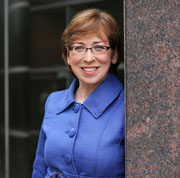Nurses have an essential role in supporting a professional work environment, and to do so, they must build a system that promotes it. That is the message from Executive Chief Nursing Officer Marilyn Dubree, MSN, R.N., in a newly-published article in the April issue of American Nurse Today magazine.

Dubree is the lead author of the article, along with co-authors April Kapu, DNP, APRN, Associate Nursing Officer for the VUMC Office of Advanced Practice; Michelle Terrell, MSN, director of Advanced Practice at the Monroe Carell Jr. Children’s Hospital at Vanderbilt; James Pichert, Ph.D., professor of Medical Education and Administration and co-founder of the Vanderbilt Center for Patient and Professional Advocacy; William Cooper, M.D., MPH, professor of Pediatrics and Health Policy, vice chair of the Department of Pediatrics and director of the Vanderbilt Center for Patient and Professional Advocacy; and Gerald Hickson, M.D., co-founder of the Vanderbilt Center for Patient and Professional Advocacy and senior vice president for Quality, Safety and Risk Prevention.
In the article, the authors advocate for high standards for nurses, backed up by creating a graduated intervention model to ensure they are met. The model acknowledges that the vast majority of nursing professionals have no issues and simply need feedback and recognition. It recognizes that anyone can suffer an occasional slip or lapse, but patterns should be identified and properly addressed to maintain an environment of professionalism, which leads to patient safety.
“Appropriate interventions thoughtfully communicated can help maintain professionalism in health care, benefitting the health care team and patients,” the article states.
The model can be envisioned as a pyramid. A single minor concern, what appears to be a slip or lapse, can be addressed with an informal conversation between peers, what the authors call a “cup of coffee” conversation.
“In our view, single incidents generally do not require investigation, which may provoke disputes, fail to identify the truth and delay sharing,” the article states. The pyramid model shows that most clinicians will change behavior after such feedback.
If not, one step up on the pyramid is addressing an apparent pattern with an “awareness intervention” — in which a peer or supervisor with access to data can confidentially demonstrate the pattern to the clinician. Awareness messages are effective in 75 to 80 percent of cases in VUMC’s work with physicians and advanced practice professionals, according to the article.
Another step up is when a pattern persists after an intervention.
This requires a guided intervention by authority, in which the clinician’s manager sits down with the clinician and implements an agreed-upon plan to reduce incidences and eliminate the pattern.
At the very top is disciplinary intervention, to be used if the earlier methods fail.
The article is the first in a series. Future articles will focus on individual layers of the pyramid.












